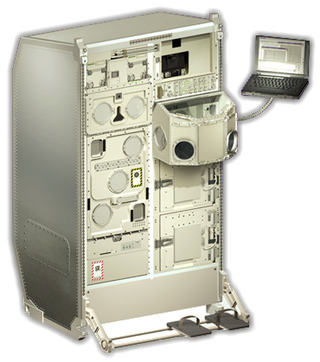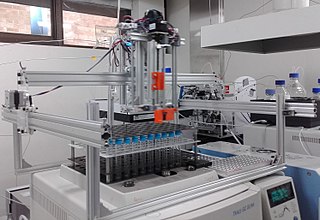
A pipette is a type of laboratory tool commonly used in chemistry and biology to transport a measured volume of liquid, often as a media dispenser. Pipettes come in several designs for various purposes with differing levels of accuracy and precision, from single piece glass pipettes to more complex adjustable or electronic pipettes. Many pipette types work by creating a partial vacuum above the liquid-holding chamber and selectively releasing this vacuum to draw up and dispense liquid. Measurement accuracy varies greatly depending on the instrument.

Digital microfluidics (DMF) is a platform for lab-on-a-chip systems that is based upon the manipulation of microdroplets. Droplets are dispensed, moved, stored, mixed, reacted, or analyzed on a platform with a set of insulated electrodes. Digital microfluidics can be used together with analytical analysis procedures such as mass spectrometry, colorimetry, electrochemical, and electrochemiluminescense.

Laboratory robotics is the act of using robots in biology, chemistry or engineering labs. For example, pharmaceutical companies employ robots to move biological or chemical samples around to synthesize novel chemical entities or to test pharmaceutical value of existing chemical matter. Advanced laboratory robotics can be used to completely automate the process of science, as in the Robot Scientist project.

A microplate, also known as a microtiter plate, microwell plate or multiwell, is a flat plate with multiple "wells" used as small test tubes. The microplate has become a standard tool in analytical research and clinical diagnostic testing laboratories. A very common usage is in the enzyme-linked immunosorbent assay (ELISA), the basis of most modern medical diagnostic testing in humans and animals.
Eppendorf, a company with its registered office in Germany, develops, produces and sells products and services for laboratories around the world.

Laboratory automation is a multi-disciplinary strategy to research, develop, optimize and capitalize on technologies in the laboratory that enable new and improved processes. Laboratory automation professionals are academic, commercial and government researchers, scientists and engineers who conduct research and develop new technologies to increase productivity, elevate experimental data quality, reduce lab process cycle times, or enable experimentation that otherwise would be impossible.

Biolab is a single-rack multi-user science payload designed for use in the Columbus laboratory of the International Space Station. Biolab support biological research on small plants, small invertebrates, microorganisms, animal cells, and tissue cultures. It includes an incubator equipped with centrifuges in which the preceding experimental subjects can be subjected to controlled levels of accelerations.

A robotic arm is a type of mechanical arm, usually programmable, with similar functions to a human arm; the arm may be the sum total of the mechanism or may be part of a more complex robot. The links of such a manipulator are connected by joints allowing either rotational motion or translational (linear) displacement. The links of the manipulator can be considered to form a kinematic chain. The terminus of the kinematic chain of the manipulator is called the end effector and it is analogous to the human hand. However, the term "robotic hand" as a synonym of the robotic arm is often proscribed.
The in-gel digestion step is a part of the sample preparation for the mass spectrometric identification of proteins in course of proteomic analysis. The method was introduced in 1992 by Rosenfeld. Innumerable modifications and improvements in the basic elements of the procedure remain.

Piston-driven air displacement pipettes are a type of micropipette, which are tools to handle volumes of liquid in the microliter scale. They are more commonly used in biology and biochemistry, and less commonly in chemistry; the equipment is susceptible to damage from many organic solvents.

Liquid-based cytology is a method of preparing samples for examination in cytopathology. The sample is collected, normally by a small brush, in the same way as for a conventional smear test, but rather than the smear being transferred directly to a microscope slide, the sample is deposited into a small bottle of preservative liquid. At the laboratory, the liquid is treated to remove other elements such as mucus before a layer of cells is placed on a slide.
Automated patch clamping is beginning to replace manual patch clamping as a method to measure the electrical activity of individual cells. Different techniques are used to automate patch clamp recordings from cells in cell culture and in vivo. This work has been ongoing since the late 1990s by research labs and companies trying to reduce its complexity and cost of patch clamping manually. Patch clamping for a long time was considered an art form and is still very time consuming and tedious, especially in vivo. The automation techniques try to reduce user error and variability in obtaining quality electrophysiology recordings from single cells.
Forward pipetting is a technique to dispense a measured quantity of liquid by means of air displacement pipette. The technique is mainly recommended for aqueous solutions, such as buffers, or diluted acids or alkalis. In case of solutions with a high viscosity or a tendency to foam, reverse pipetting is more suitable.
Reverse pipetting is a technique to dispense a measured quantity of liquid by means of air displacement pipette. The technique is mainly recommended for solutions with a high viscosity or a tendency to foam: as it reduces the risk of splashing, foam or bubble formation. Reverse pipetting is more precise in dispensing small volumes of liquids containing proteins and biological solutions compared to forward pipetting, which is mostly used for aqueous solutions, such as buffers, diluted acids or alkalis.

A media dispenser or a culture media dispenser is a device for repeatedly delivering small fixed volumes of liquid such as a laboratory growth medium like molten agar or caustic or volatile solvents like toluene into a series of receptacles. It is often important that such dispensers operate without biological or chemical contamination, and so must be internally sealed from the environment and designed for easy cleaning and sterilization before use. At a minimum, a media dispenser consists of some kind of pump connected to a length of discharge tubing or a spout. Dispensers used in laboratories are also frequently connected to microcontrollers to regulate the speed and volume of the medium as it leaves the pump.

Automated synthesis or automatic synthesis is a set of techniques that use robotic equipment to perform chemical synthesis in an automated way. Automating processes allows for higher efficiency and product quality although automation technology can be cost-prohibitive and there are concerns regarding overdependence and job displacement. Chemical processes were automated throughout the 19th and 20th centuries, with major developments happening in the previous thirty years, as technology advanced. Tasks that are performed may include: synthesis in variety of different conditions, sample preparation, purification, and extractions. Applications of automated synthesis are found on research and industrial scales in a wide variety of fields including polymers, personal care, and radiosynthesis.

An autosampler is commonly a device that is coupled to an analytical instrument providing samples periodically for analysis. An autosampler can also be understood as a device that collects samples periodically from a large sample source, like the atmosphere or a lake, for example.
Opentrons are liquid handling robots driven by open source software, which can be used by scientists to manipulate small volumes of liquids for the purpose of undertaking biochemical or chemical reactions. The instrument is used primarily by researchers and scientists interested in DIY biology but is increasingly being used by other biologists. They are produced by Opentrons Labworks.
A cloud laboratory is a heavily automated, centralized research laboratory where scientists can run an experiment from a computer in a remote location. Cloud laboratories offer the execution of life science research experiments under a cloud computing service model, allowing researchers to retain full control over experimental design. Users create experimental protocols through a high-level API and the experiment is executed in the cloud laboratory, with no need for the user to be involved.

A bulk reagent dispenser (BRD) is a type of commercially available laboratory equipment that dispenses liquid reagents in an automated fashion into microplates, multiwell plates, or microplate-like reservoirs, and specifically have the ability to transfer liquid from a "bulk" source reservoir, but still dispense a programmable but relatively small volume of liquid, i.e. 10-500 µL. They are often used in drug discovery or pharmaceutical laboratories. They are distinguished from semi-automated or manual (hand-operated) equipment like pipettes, as well as from automated laboratory equipment that dispenses from relatively small source reservoirs such as acoustic liquid handlers or liquid handling robots.
















